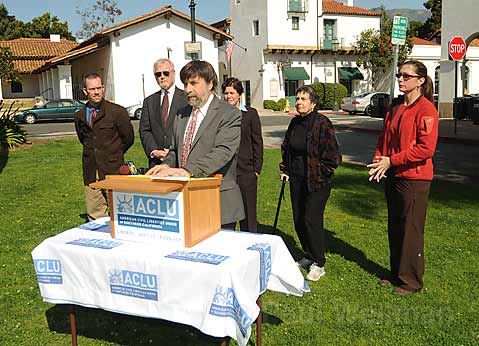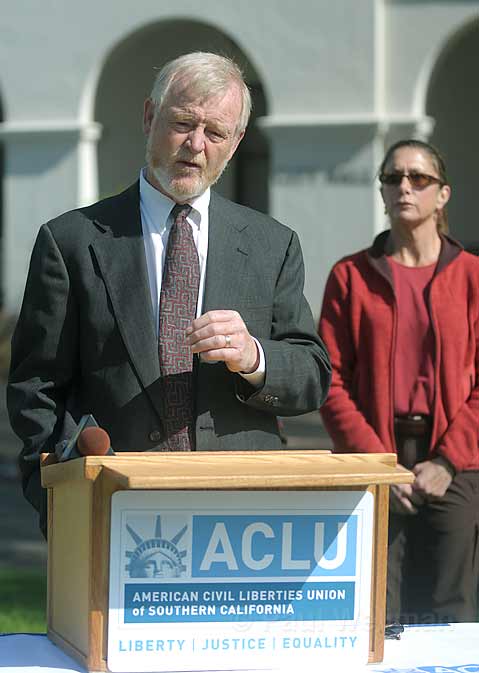ACLU Sues City
Says Anti-Camping Laws Criminalize Poor and Disabled

With the closure of Casa Esperanza’s winter shelter fast approaching, the American Civil Liberties Union (ACLU) filed a federal lawsuit against the City of Santa Barbara Friday seeking an end to its prohibitions against sleeping and camping in public. The group said the laws criminalize impoverished, disabled residents who have no alternative place to lay their heads.
The ACLU of Southern California is also considering seeking a court order to keep the Casa Esperanza shelter open beyond April 1, when half of its 200 beds are scheduled to disappear and 100 homeless will be sent back on the streets where they are liable to be ticketed and ultimately sent to jail, said the group’s legal director Mark Rosenbaum.
“Essentially, the city and its law-enforcement personnel treat the chronically homeless as if they were outlaws,” said Rosenbaum.
At a press conference in front of City Hall on Friday morning, March 6, seven homeless advocates decried the inhumanity of the city’s 30-year-old anti-sleeping and anti-camping ordinances. Lynn Jahnke, a physician who treats the homeless, said with only 30 medical beds after the first of April, Casa Esperanza will have to decide who is sickest and relegate those deemed less ill-people who also have acute and chronic illnesses-to sleeping under bushes.
Given the ACLU of Southern California’s recent track record suing municipalities on this issue, the City of Santa Barbara is likely to take the matter quite seriously. In 2003, Rosenbaum and his ACLU colleagues sued the City of Los Angeles over its practice of citing homeless individuals for sleeping under tarps and cardboard along L.A.’s skid row. Though initially unsuccessful, the ACLU prevailed at the Ninth Circuit Court of Appeals and Los Angeles Police soon agreed to stop citing and arresting skid row homeless at night. Now they only resume the practice at 6 a.m. This Tuesday, the City of Laguna Beach repealed its anti-sleeping ordinance as a direct result of the lawsuit brought by the ACLU of Southern California. That suit elicited debate in the opinion pages of Laguna Beach newspapers and the city officially backed down.
Santa Barbara’s anti-sleeping and anti-camping ordinances have a long and notorious history. Enacted in 1979 after two students were murdered while camping on an Isla Vista beach, a campaign against the ordinances eventually began percolating and ultimately erupted into a highly visible, nationally observed protest. With help from the late homeless activist Mitch Snyder in the mid-’80s, Santa Barbara’s homeless were galvanized, and even Doonesbury comic strip author Gary Trudeau mocked the laws in a week’s worth of the syndicated Doonesbury strip. (Many of the homeless who participated in that campaign have since died.)

More recently, the laws have been challenged by attorney Glen Mowrer of the Legal Project, part of the Santa Barbara nonprofit Committee for Social Justice. Mowrer defended in court as many as 150 separate cases of alleged public sleeping between 2000 and 2006 and prevailed in the vast majority. Mowrer said it proved the laws could not be prosecuted. He and other attorneys met with Santa Barbara City Attorney Steve Wiley following ACLU’s Los Angeles victory and law enforcement skid row compromise. “We said, ‘This stuff applies to Santa Barbara. What can we do to bring this kind of a solution here?'” According to Mowrer, the city did not give a substantive response.
“The city has essentially requested litigation,” Mowrer said.
Steve Wiley couldn’t be reached Friday because the city offices were closed.
At a meeting of homeless activists and social workers Friday afternoon, City Councilmember Das Williams said though he had not had a chance to read the suit yet, he expected the city would handle it constructively.
“As someone who had to live in my vehicle when I was younger, I am diametrically opposed to the criminalization of poverty. I know the city is doing some very good things to transition people out of homelessness and into housing. But if there’s something we’re not doing, or if there’s something we’re doing that works against the chance to deal compassionately with the homeless, then I’m glad we’ll have a chance to look at it,” he said.
People who work directly with Santa Barbara’s homeless said 11 of them have died since the year began, one following a violent altercation over his sleeping bag. The high number of deaths alarms activists. Eighteen homeless people died here during 2008.
On a separate track, Casa Esperanza has recently entered into discussions with the city about provisionally increasing the number of beds in its non-winter shelter from 100 to 136. Because of the deaths, including two as a result of violent assaults in the past nine months, and having identified 36 individuals who would be placed in direct jeopardy if they were sent back onto the streets April 1, the shelter’s position is that there is currently an emergency among the homeless that warrants a provisional expansion.
Casa Esperanza’s Conditional Use Permit (CUP) allows only 100 beds during non-winter months; 30 of them are medical; 70 are for those judged to be actively working to get off the streets.
Two weeks ago, the city unanimously embraced a 12-point plan to curb panhandling in the downtown areas and the ill effect business owners say the homeless presence has on tourists and other customers. Though still not totally formed, the plan includes stricter anti-panhandling laws, as well as measures to house the homeless in motels when the shelters are full. A significant segment of city residents are vocally opposed to services being provided to area homeless, though, believing such policies are a virtual calling card to other homeless people to come here.
Friday’s suit was brought on behalf of the city’s disabled homeless as well as four particular homeless individuals residing at Casa Esperanza who stand to be evicted April 1. Many of the homeless in Santa Barbara, as elsewhere, have a physical or mental disability, or both, that impedes or prevents their ability to obtain housing and/or employment.
A sweeping and ambitious, federally sponsored Ten Point Plan to End Chronic Homelessness in the county is currently underway. When and if it is fully enacted, it will include housing in a “Safe Haven” model, in which formerly homeless can live in complexes where social and substance abuse services are available on site.
Meanwhile, Rosenbaum said numerous studies of homelessness in both the city and county over the years, including one as recent as 2006, repeatedly attest to the dearth of shelter beds compared to the need. Given that fact, Rosenbaum said, to ticket and arrest the poor for sleeping outside constitutes a violation of their Constitutional rights under the Equal Protection clause of the 14th Amendment of the U.S. Constitution, among others.
“By citing and arresting mentally ill or physically disabled homeless persons for sleeping in public places when there are no reasonable alternatives available to them, the city engages in arbitrary and unreasonable conduct that shocks the conscience and bears no reasonable relation to public health and safety,” the ACLU’s Rosenbaum said.



